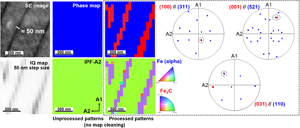Published online by Cambridge University Press: 08 April 2022

The crystallographic analysis of nanoscale phases with dimensions well below the spatial probing volume of electron backscatter diffraction (EBSD) traditionally rely on electron microscopy in transmission (either in SEM or TEM), because EBSD patterns are invariably dominated by the matrix phase contribution and present seemingly no trace from such nanoscale phases. Yet, this study shows that such nanoscale features generate a very faint but valuable secondary diffraction signal which can be retrieved. A diffraction pattern postprocessing method is presented which focuses on the detection of such secondary signal emitted by nanoscale minority phases in overlapped patterns dominated by a dominant matrix signal. The predominant, majority phase contribution in EBSD patterns is removed by a close-neighbor pattern subtraction routine, after which both the conventional Hough indexing method as well as pattern matching methods can be used to reveal the crystallography, spatial distribution, morphology, and orientation of nanoscale minority phases initially absent from EBSD maps. Nanolamellar pearlitic steel, which has long been out of reach for EBSD, has been chosen as an application example.